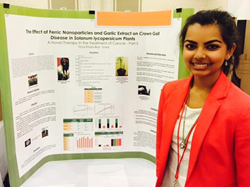
Washington, DC (PRWEB) May 12, 2015
Top honors and educational scholarships have been awarded to a select group of elite Science, Technology, Engineering, and Mathematics (STEM) high school students for their winning research projects at the U.S. Army, Navy and Air Force’s annual STEM competition, the National Junior Science & Humanities Symposium (JSHS).
“Every year I’m blown away by the depth of research presented here at JSHS as well as the work done at the regional competitions,” said Ms. Mary J. Miller, Deputy Assistant Secretary of the Army for Research and Technology. “I am continually impressed by both the quality and level of work that students bring to this event. This is a group of young adults that have ignored the limitations that society often attributes to the ‘younger generation.’”
“The United States has become a global leader, in large part, through the genius and hard work of its scientists, engineers and innovators. Welcome to that select group,” Miller told the students. “While the U.S. is being challenged by others across the world, you are posed to make the difference. We need bright minds like yours to help keep the U.S. dominant in our global economy. We need bright minds like yours to keep our Armed Forces superior to all others.”
To earn a spot at JSHS, students first had to be one of the top three winners at one of 46 regional events. At the National competition, they presented their research papers and posters to judges who are actively engaged in research and development at Department of Defense (DoD) and university laboratories. The first place winner in each category earned a $ 12,000 scholarship; second place, $ 8,000; and third place, $ 4,000.
“These regional and national science events are so beneficial for all students. There’s no substitute for being in a group of high-performing peers who challenge you to do your best work,” said Dr. Abel Bult-Ito, Professor at the University of Alaska Fairbanks and a director and mentor in the Alaska JSHS program. “Students who come here are inspired by each other. And they each earned the right to attend by doing real new science, which they conceived and performed themselves and whose findings are examined by others.”
Even as the 53rd Annual JSHS concludes, teachers and students should plan ahead for the regional Junior Science and Humanities Symposia that will be held across the country beginning in winter, 2016. Science teachers and students can visit http://www.jshs.org/getinvolved.htm to learn more about JSHS regional and national events so they can participate next year.
The winning projects in each category are:
3RD PLACE
Environmental Science
Ethan Novek, Connecticut JSHS
Novel Low Grade Waste Heat Recovery System with Simultaneous Electricity Generation, Carbon Sequestration and Urea Production
Life Sciences
Moez Hayat, Louisiana JSHS
A Novel Platform for the Measurement of Hydrogen Sulfide
Medicine & Health
Erica Lin, New York Metro JSHS
Epithelial Mesenchymal Transition: A Novel Target for Perineural Invasion Inhibition in Pancreatic Adenocarcinoma
Mathematics & Computer Science
Jessica Li, New Jersey at Rutgers JSHS
On the Modeling of Snowflake Growth Using Hexagonal Automata
Physical Sciences
Matthew Sturm, Hawaii JSHS
Observational Detection of Solar g-mode Oscillations Using Doppler Velocity Signals
Chemistry
Carolyn Jons, North Central JSHS
Improved Efficiency of Seawater Steam Generation Using Carbon Nanoparticles
Engineering
Christopher Romanoski, Tennessee JSHS
A Mathematical Analysis of the Wright Brothers’ Wind Tunnel Tests
2nd PLACE
Environmental Science
Deepika Kurup, Northern New England JSHS
Integrating Filtration with an Advanced Oxidation Process for Degrading Organics and Inactivating Bacteria in Wastewater
Life Sciences
Piyush Pillarisetti, Philadelphia JSHS
Identification of Multi-Functional Anti-Cancer Compounds Using Computational Analysis
Medicine & Health
Amol Punjabi, Southern New England JSHS
Rethinking Drug Discovery: New Algorithms for Virtual Drug Screening
Mathematics & Computer Science
Sasank Vishnubhatla, Kentucky JSHS
An Asymmetric Elliptic Curve Algorithm to Increase Entropy and Decrease Computation Time of Iris Recognition
Physical Sciences
Josh Ludwigsen, Southwest JSHS
Testing and Finite Element Modeling of Head Impacts in Sports
Chemistry
Mokshin Suri, Texas JSHS
Analysis of Structural Fabrication and Performance in Dye Sensitized and Perovskite Solar Cells
Engineering
Jared Adams, South Carolina JSHS
A New Approach to Treating Gait Disabilities in Children
1st PLACE
Environmental Science
Ian Fleming, Alaska JSHS
Survival of Hatching Coho Salmon (Oncorhynchus kisutch) in Relation to the Application of Glyphosate Based Herbicides
Life Sciences:
Alon Millet, New Jersey Monmouth JSHS
Phytobiological Responses to Cellulose Binding Domain: Mechanisms, Implications, and Commercialization
Medicine & Health
Juliet Ivanov, Upstate New York JSHS
Investigating the Protective Effects of Interleukin 22 on Intestinal Epithelium: Potential Graft-versus-Host Disease Treatment
Mathematics & Computer Science
Melissa Yu, Tennessee JSHS
Developing an Automatic Nonrigid Image Registration Algorithm for Nanoscience Research
Physical Sciences
Arjun Dhawan, Indiana JSHS
Object Recognition for the Visually Impaired
Chemistry
Jessica Kim, New York (Long Island) JSHS
Improving the Efficiency of Inverted Organic Photovoltaics with
Gold Functionalized Reduced Graphene Oxide and Phase-Separated Polymer Morphology
Engineering
Dhruv Iyer, Arizona JSHS
Development and Optimization of a Multimodal Natural User Interface for
use by People with Severe Motor Disabilities to Play Computer Games
The Army, Navy, and Air Force congratulate these students for their achievements.
About JSHS
The JSHS is a tri-service program funded by the Army, Navy and Air Force that encourages high school students to conduct original research in STEM. JSHS sponsors include: Office of the Assistant Secretary of the Army (Acquisition, Logistics & Technology); Office of Naval Research, Arlington, VA; and Air Force Office of Scientific Research, Washington, DC, in cooperation with higher education. The National JSHS Program is administered by the Academy of Applied Science, a non-profit educational organization located in Concord, New Hampshire. Details on the JSHS Regional and National events are available at http://www.jshs.org/.
About AEOP
The Army Educational Outreach Program (AEOP) is comprised of Army-sponsored research, education, competitions, internships and practical experiences designed to engage and guide students as well as teachers in science, technology, engineering, and mathematics (STEM). From elementary school through graduate school, students of all proficiency levels, interests, ethnic, economic and academic backgrounds are encouraged to participate in real world experiences involving these important disciplines. More information is available at http://www.usaeop.com/, at the Twitter handle @USAEOP and at http://www.facebook.com/goAEOP.
About AAS
The Academy of Applied Science (AAS) administers STEM programs where students apply scientific knowledge to life, research and inventions. Its programs spark creativity in young students, encourage the rising generation of teen mathematicians, scientists and engineers with recognition for their efforts, and provide scholarships and apprenticeships for high school students interested in pursuing careers in math, science and technology. Its influence, encouragement and assistance annually reach over 12,000 students nationwide. More information is available at http://www.aas-world.org.
###


